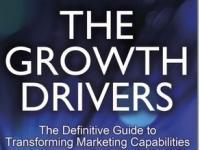With a foreword by Sir Roger Carr, Chairman of Centrica and Chairman of the CBI, and cover raves by luminaries including Professor Malcolm McDonald, Keith Weed and our very own Hugh Burkitt, The Growth Drivers is clearly an important addition to the literature of marketing.
The growth drivers of the title are: 1] Marketing (the discipline itself); 2] Marketers (the people responsible for specialist marketing tasks and activities); and 3] Marketing Capabilities (the abilities of people, teams and organizations to manage marketing activities). Using impressive models such as The Growth Propeller and The Brand Learning Wheel, the authors cast an analytical but practical eye over, in particular, the third of those drivers, to help practitioners understand how to build the marketing capabilities necessary to drive growth.
Throughout, points and processes are supported and clarified by reference to real examples of activities from leading enterprises including AkzoNobel, Diageo, the Unilever Marketing Academy (Unilever is the alma mater of the two authors), Virgin, BMW and more.
.So, there is no doubt that this is a very valuable volume; a comprehensive manual for marketers themselves and for their colleagues in other parts of the business.
And yet, and yet, the very fact that it needed to be written causes me to wonder what is going on out there. Isn’t it worrying, in the second decade of the 21st century, that a marketing book has to set the scene saying, “Many organizations and their leaders do not fully understand what marketing is all about”? This is surely a terrible indictment of all of us who have devoted our careers to marketing.
I winced when I first read, in Thomas H. Davenport’s Process Innovation , “[G]iven the nature of the people attracted to marketing and advertising, not even the most sophisticated marketers in consumer goods firms have explicitly recognized the potential for applying process structures and disciplines to their work.” Ouch. But that was written around 20 years ago. Surely things have changed? Well, not as much as one might have hoped, it seems.
Andy Bird and Mhairi McEwan state that “The widespread misunderstandings about what marketers do arise from the fact that there are two dimensions to their role as growth drivers … One, the better understood dimension, is focused on driving growth through communicating and promoting the company’s product and service offerings through advertising, promotion, PR, etc. However, the second more strategic dimension of a marketer’s role is to ensure the organization is actively anticipating, creating and delivering products and services that consumers and customers want and need in the first place.”
If the “widespread misunderstandings” truly exist, The Marketing Society’s 2005 Marketing Manifesto project is patently incomplete. Which is rather depressing. But let’s be positive. Let me take you back nearly 40 years to an essay published in 1974 – The Purpose and Objectives of a Business , by the late, great Peter Drucker: “Because its purpose is to create a customer, the business enterprise has two – and only these two – basic functions: marketing and innovation. … Marketing and innovation are the foundation areas in objective setting. It is in these two areas that a business obtains its results. It is performance and contribution in these areas for which a customer pays.”
No equivocation there: Marketing must be a leading driver of profitable growth. So, it makes urgent sense to read and put into practice the lessons of The Growth Drivers.
Peter Barrett, Director of Marketing, Business & Application Services Fujitsu, reads The Growth Drivers and urges you to read and put into practice its lessons.
How do you transform marketing capabilities in order to drive profitable growth for the business? That’s the exam question Bird and McEwan set themselves. As experienced international practitioners – they set up the Unilever Marketing Academy together – the authors provide a good mix of concepts, case studies and quotes from senior marketing executives in well-known international businesses. This is NOT about setting up a training programme from the ‘bottom up’, rather it examines how you make your business more customer-centric and get marketing to act as a catalyst for broader organisational change from the ‘top down’. It focuses on which areas are critical (the Growth Propeller) and how you utilise the core drivers – people, structure, skills, process and culture – to make this happen (the Brand Learning Wheel).
All the usual rules apply: get board/CEO sponsorship, link this work to delivering key business goals, integrate with the rest of the business, embed into ‘the way you do things around here’ and measure progress. But be warned. This is not insignificant and will take time and considerable effort to effectively change the ‘hard wiring’ of your organisation. (Presumably this was one of the reasons the book was written, as the authors now run a consultancy that helps organisations undertake this type of transformation.)
Overall, I found it easy to read, practical and a good source of insight from those practitioners who have pioneered this approach – and have the scars to prove it!
Join The Marketing Society Book Club. If you are a member of The Marketing Society you could write a 300-word review for the Marketing Society’s blog. Contact Will Armstrong to get involved. Find out more about the benefits of joining The Marketing Society’s exclusive network.
Newsletter
Enjoy this? Get more.
Our monthly newsletter, The Edit, curates the very best of our latest content including articles, podcasts, video.
Become a member
Not a member yet?
Now it's time for you and your team to get involved. Get access to world-class events, exclusive publications, professional development, partner discounts and the chance to grow your network.

